4 Types of Stainless Steel Flatware: Why the Material of Forks, Knives, and Spoons Matters
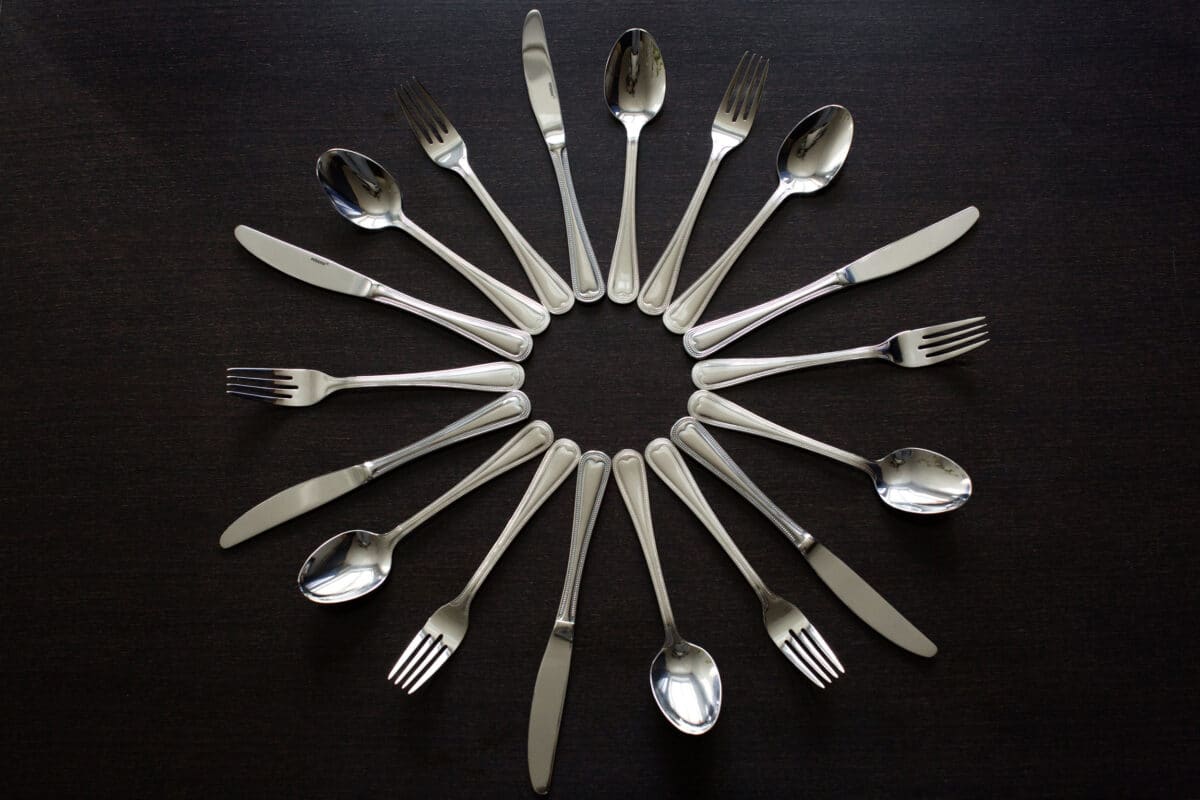
Imagine packing up your china cabinet for a parking lot tailgate party, or a bartender pouring you their finest champagne into a paper cup—something seems a bit off, right?
Whether it’s a sit-down restaurant, quick-serve station, or classy catering service, we have to set the right tone for our guests, gently guiding them toward the right feeling for their experience. We bring out the fine china for holidays and celebrations that have a deep personal meaning for our family; we grab those paper cups when we want to have a good time and not worry about the clean up afterwards.
While it’s easy to point out the tone that expensive plates and disposable drinkware can set, one part of the tabletop display can fly under the radar—cutlery.
In this article, we’ll translate industry terms for the material of your flatware options in order to help you choose which type best suits the feel of your foodservice.
Looking for the highest quality flatware? Shop 18/10 flatware
Want the most affordable and convenient flatware? Shop 18/0 flatware
In need of heavyweight, durable flatware that won’t break the bank? Shop 18/8 flatware
The Material
Like paper or porcelain plateware, the impression left by a plastic knife vs. a steel knife seems rather obvious: plastic for picnics, metal for sit-down meals. All this would be easy enough if there was only one, single type of metal.
Luckily, flatware manufacturers stick to two universal truths for us:
- Metal forks, knives, and spoons used in commercial kitchens are stainless steel.
- Stainless steel is graded and numbered for durability and composition.
Those in the industry may be familiar with the grading system of stainless steel when picking out their work tables, which typically call out the gauge (thickness) in addition to steel grade (430, 304, etc.).
Flatware keeps things even simpler: the stainless steel grade of flatware is communicated in fractions that reflect chromium and nickel composition. While there’s technically 100+ grades of stainless steel, there’s only four in flatware: 13/0, 18/0, 18/8, and 18/10.
13/0
This is the most affordable grade of stainless steel in the restaurant industry and the only option reserved exclusively for table knives, steak knives, butter knives, or dessert knives.
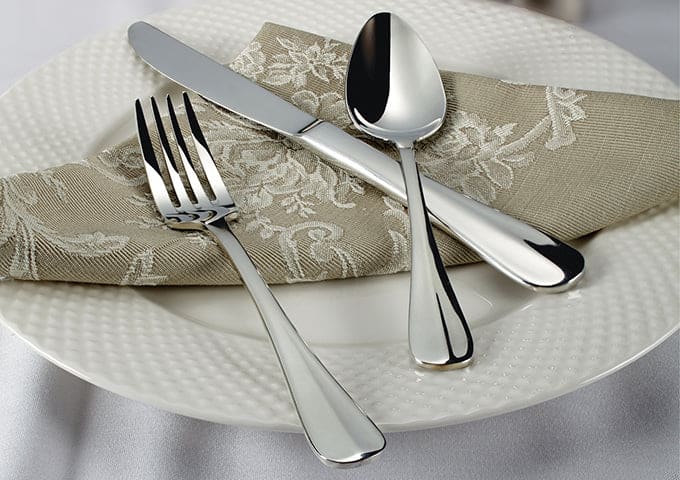
Have you ever noticed those old dinner knives in your cutlery drawer showing more discoloration than the rest of your utensils? That’s probably the 13/0 fraction at work.
The “13” in this fraction means there’s 13% chromium in this product, while the “0” means 0% nickel. Chromium puts the stainless factor into steel, while nickel adds strength and shine. The rest of the percentage ratio? You guessed it—steel.
A 13/0 blend is reserved for knives for two reasons: it’s the easiest grade to add serrated edges to, and it’s the most bendable.
In addition to being the lightest, most bendable of the grades available, you’ll also notice that the 13/0 flatware grade is less shiny and the least resistant to staining. Since it’s more likely to damage or discolor, you’ll be replacing it more often, and it will make less of a visual impact on a customer.
This grade is best for casual foodservices—catering operations that serve massive crowds, or burger joints with some outdoor seating that want to give customers something with visual appeal a step above disposable options.
| Weight | Service | Cost |
| Medium | Casual Dining, Cafeterias, Quick-Service | $ |
18/0
The next grade up, 18/0 stainless steel is the baseline ratio for forks and spoons.
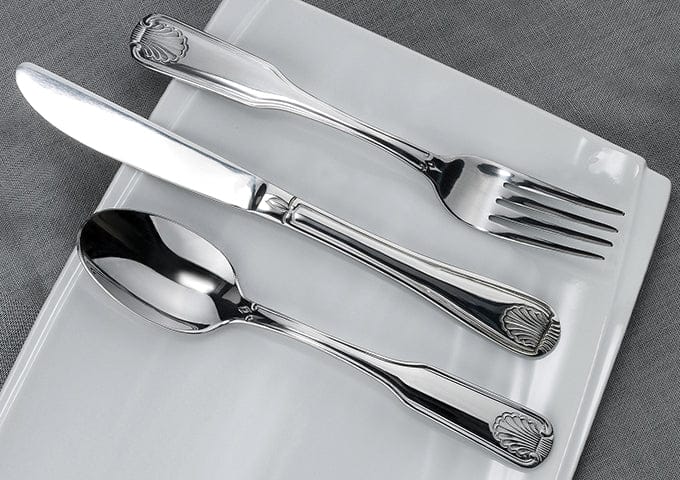
You can now guess the meaning of this fraction—18% chromium and 0% nickel. Although the lower shine and greater bendability factors remain the same compared to the 13/0 products, we have 5% more chromium. That may not seem like the biggest difference, but after using both for a while, you’ll definitely know which is which.
What stands out about 18/0 stainless steel is surface durability. While a knife with a 13/0 ratio may look the same in terms of luster, the 18/0 knife will show less signs of corrosion over time.
A big reason why 0% nickel flatware is so prevalent in the industry is due to magnetism. The more nickel that’s present, the less magnetic the steel becomes—and without magnetism, restaurants can’t use magnetic cutlery catchers. These magically magnetic trash container lids ensure those forks, knives, and spoons aren’t tossed out with the rest of the leftovers on a customer’s plate.
The biggest advantage of 18/0 over the 13/0 grade is the ability to match your cutlery across utensils. You won’t find spoons or forks in 13/0 grade, so if matched and magnetic are your biggest priorities, this grade is for you.
Like 13/0, the 18/0 grade fits in best with large-scale casual dining: cafeterias and quick-service restaurants where speed and scale are the biggest service hurdles. Lighter in weight and durability than higher grades, expect to replace 18/0 grade cutlery roughly every two years.
| Weight | Service | Cost |
| Medium–Heavy | Casual Dining, Cafeterias, Quick-Service | $$ |
18/8
Taking our third step up the graded ladder, 18/8 cutlery has 18% chromium and 8% nickel. For all of those that want sturdy, shiny forks, knives and spoons, this is where things get interesting.
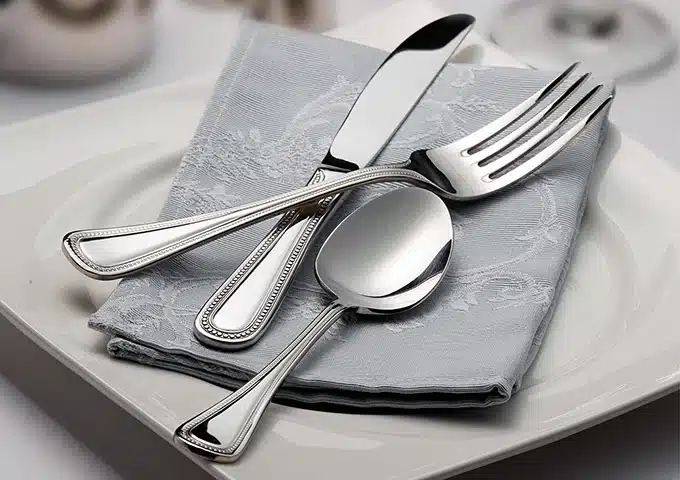
For most of us, if it doesn’t shine, then it doesn’t really feel like stainless steel. A clear, shiny surface shows that the item is clean—exactly why we love stainless steel in our kitchens and bathrooms.
The 8% nickel in this grade of flatware not only adds that clean shine, but it also adds considerable strength to the utensil. Have you ever bent a stainless steel spoon while trying to scoop ice cream straight from the freezer? Yeah, me neither… but for all those that might run into that dilemma, it will take a lot more force to bend an 18/8 spoon compared to an 18/0 grade.
To emphasize that less-bendable nature, manufacturers tend to add more weight and thickness to this grade—a trend they follow even more strongly for 18/10 utensils. You’ll lose the practical convenience of magnetism with this grade, but you’ll gain a lot in terms of customer perception and utensil durability.
The 18/8 grade utensil is a perfect fit for casual upscale dining: bistros, cafes, banquet halls, and white-collar caterers. For any foodservice that wants an overall classy feel but not break the bank over minute, aesthetic detailing, 18/8 is your match.
| Weight | Service | Cost |
| Heavy–Extra Heavy | Bistros, Cafes, Banquet Halls, Upscale Catering | $$$ |
18/10
If you perked up at the shinier nature of 18/8 grade stainless steel, then you’ll really love the 18/10 grade. This grade has the highest level of nickel available in commercial flatware, making it the sturdiest, shiniest, most durable grade of utensil available.
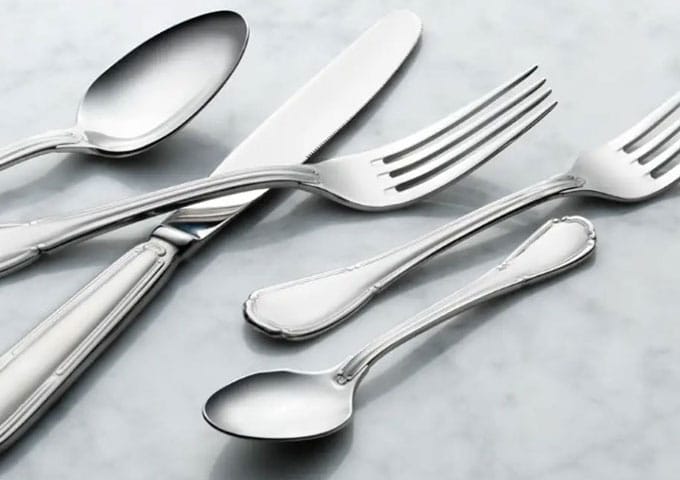
It will be no surprise that the brightest and strongest cutlery will command the highest prices. But, foodservices looking for the most elegant flatware have likely already invested in the most elegant dinnerware and drinkware, so at this point, anything less than the best will feel rather out of place—just like bringing china to your tailgate.
Cutlery in this category won’t just have the best material makeup, but it will also have the most elegant design. You’ll see stylish, modern designs that still feel heavy and sturdy, for instance, or you’ll find more ornately carved handle designs that drift into antique silverware territory.
It’s tough to gauge just how long an individual fork, knife, or spoon will last in a commercial setting—with differences in dishwashing, the amount of use it sees, or even accidental theft rates—but in a perfect environment, an 18/10 utensil can easily last a decade or more.
18/10 is the top shelf, top drawer champion of commercial cutlery. For any service that asks a customer to maintain a dress code and to pay “special occasion”-level prices for an entrée, 18/10 grade utensils are a must.
| Weight | Service | Cost |
| Extra Heavy | Fine Dining, Hotels, Country Clubs | $$$$ |
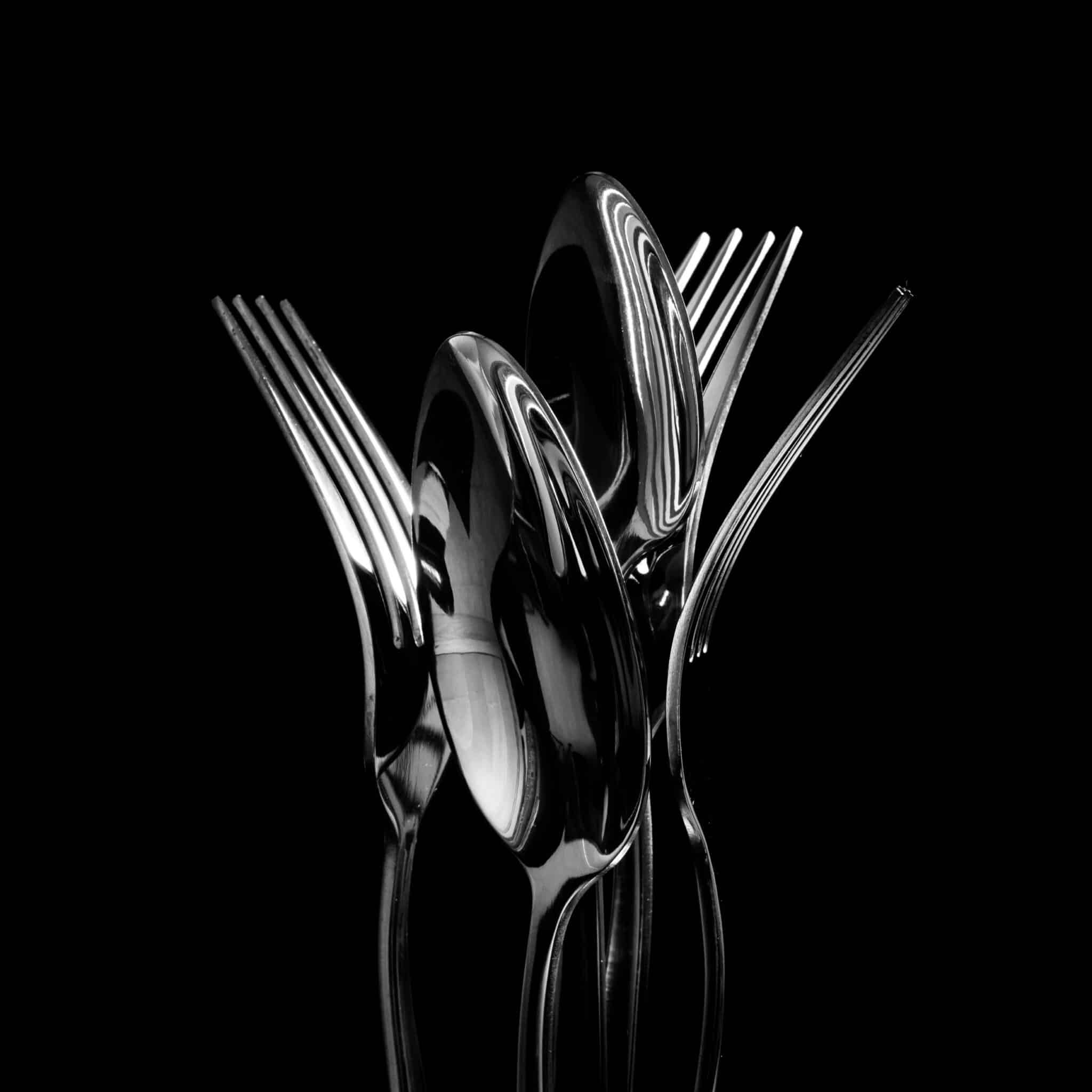
Don’t Let Bad Cutlery Leave a Bad Taste
Customers have a certain level of expectation when they choose your service. Meet it.
Invest in flatware that matches the feeling you want to give your guest. If your menu, your décor, and your waitstaff uniforms all reflect an elegant French bistro, then your flatware should match that elegance. If the arcade and “Kids Under 12 Eat Free” sign in your dining room point to a casual, fun-for-all-ages atmosphere, then there’s no need to overthink and overinvest in your cutlery.
As prices across the menu increase and customers treat restaurants more like luxury experiences, it’s increasingly important for customer retention to respect their expectation of your business.
Customers will come for your food. They’ll come back for the feeling.
Interested in exploring our flatware options?
For the most elevated flatware, it’s hard to beat Cardinal
For tasteful designs at more affordable levels, Libbey offers a wide selection
